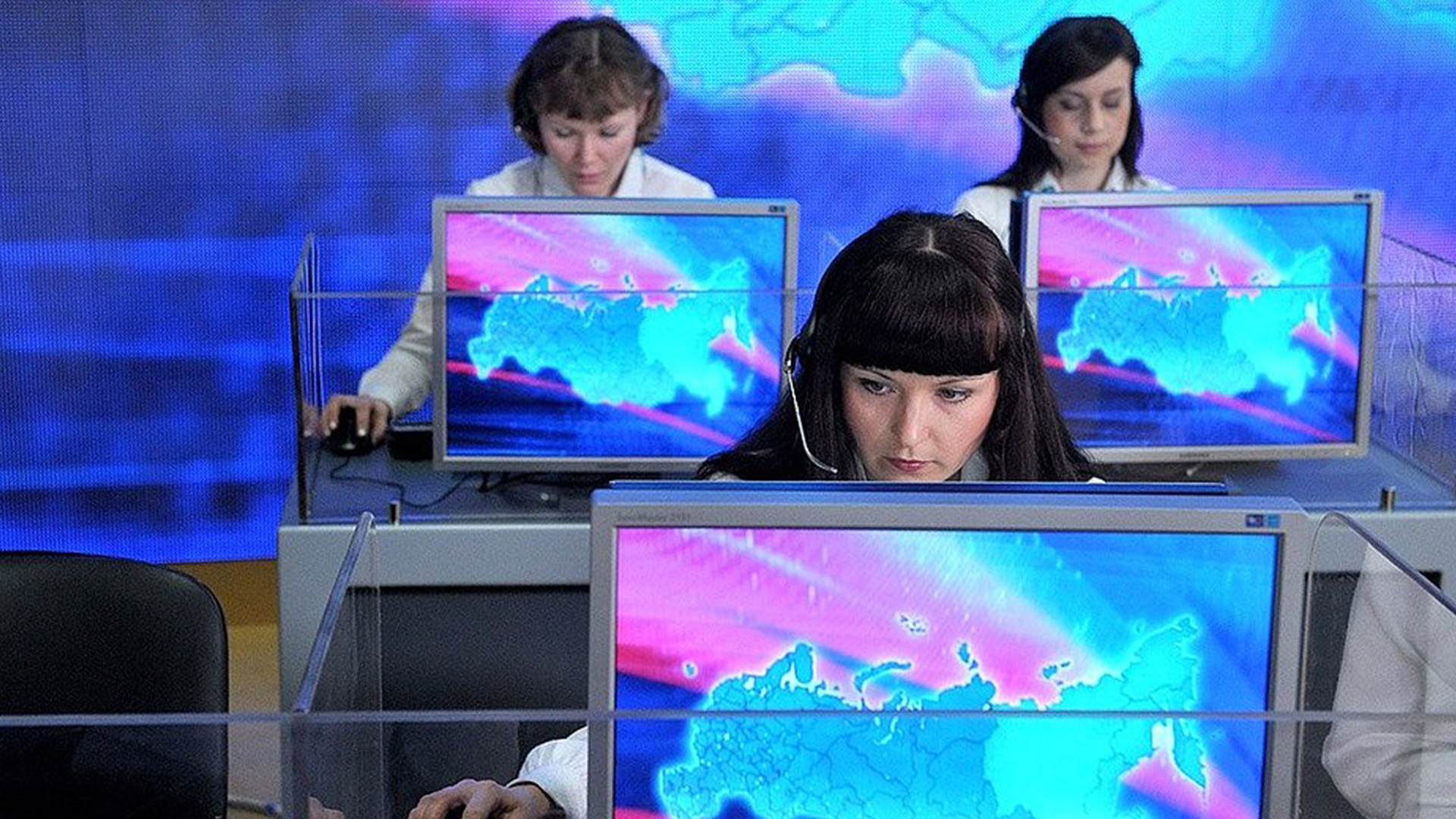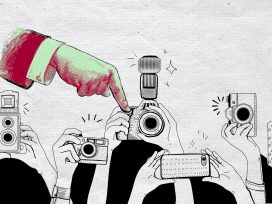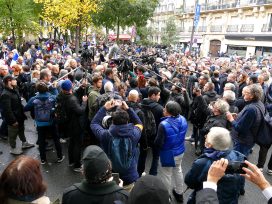The Russian aggression against Georgia in 2008 and Ukraine in 2014 introduced a new type of warfare which has proven very effective in the digital era. This new type of war is no longer aimed at taking over territories or resources, but at influencing human behaviour. It involves non-kinetic activities, which are undertaken in cyberspace and are cheaper than traditional methods; and, most importantly, they are more effective when applied towards western societies, which are largely unprepared for this kind of hostile action.
An alarming number of people in the West still refuse to believe in the scale and impact of Russia’s intervention in their states. Moreover, in parallel to partial improvements in analytical and preventive mechanisms, a series of other, negative trends have started to emerge. Among the most dangerous are: populism, polarisation and the radicalisation of public discourse. This context presents journalism with new problems and challenges. Yet there seems to be neither an understanding of the situation nor an agreement about how to respond to it. This is true at both domestic and international levels.
Journalist vs media worker
Limited funds and human resources are clearly among the biggest problems that media organisations face today. Falling fees for individual writers, the result of market trends, lead to lower quality journalism. Low pay discourages intelligent young people from entering the field of journalism. It is also a reflection of society’s attitude towards information. Essentially, we get what we pay for.
The demand for immediate information also hinders the process of verification, which explains why some journalists and media outlets publish information that is false or misleading. In short, largely as a result of the growing influences and trends in social media, the nature of the media in recent years has changed. Journalists have little time for content-related work or investigative journalism and news production has been replaced by the passive repetition of press releases. Not surprisingly, the term ‘media worker’ is becoming more and more popular and sometimes even replaces the word ‘journalist’.
The need to attract advertisers explains the decisions made by media owners. The search for profit can also be noticed in the selection of themes or content of many outlets. The situation of local and regional media can be considered even more worrying. In addition to the challenges they share with national media, they are often victims of local political and business pressures. Insufficient attention is paid to investigative journalism – not only the kind that focuses on financial and political matters, but also the kind that highlights disinformation, its sources, mechanisms and actors. Instead, the overall attitude to media content shared by many journalists can be paraphrased with the following dictate: ‘articles should be short and simple’.
This false assumption is now backfiring, since it has evidently contributed to lower quality journalism. Complex issues cannot be properly understood with short and simple accounts. The new threats require a greater understanding of psychological, informational and digital matters. Unfortunately, the media world seems unprepared for such challenges.
Parallel trends
The following broad trends are now taking place in the West:
- information-related threats have become more popular;
- there are not enough experts on disinformation;
- state structures are unwilling to share evidence on disinformation and fail to inform the public about their activities in this area;
- there is a lack of policy co-ordination aimed at improving citizens’ safety in information and cyber spheres, which leads to societies being insufficiently aware of the threats;
- there is too much interest in some phenomena (e.g. fake news, bots and trolls), which are in fact part of larger problems;
- and profit-driven agencies have emerged that seek to take advantage of an increased interest in information threats, but which often lack knowledge and experience.
The parallel development of these trends leads to even greater chaos and influences the perception of the real problems and the necessary solutions. Thus, journalists play an even more important role in popularising new facts, research findings, analyses or reports on information security.
Noticeably, however, there is little consensus in the media world. There is no agreed definition of the information threats nor on the methods that should be used to fight them. Most importantly, there is no agreement on the role that media plays in the process as a whole. One consequence is that some journalists have taken on the role of analyst or expert. Yet, almost simultaneously, a different problem has emerged: there is a very limited exchange of knowledge and experience between different professional groups. While journalists tend to stay within their own areas of expertise, so do experts and academics.
A lack of interaction and of sharing of data and knowledge between disciplines generates some grave problems. It limits the development of effective solutions as well and dilutes the perception of information threats. There is little overlap between parallel information worlds, which only causes more confusion for the ‘average’ consumer of information.
Nonetheless, some groups, including public officials, interact with and influence one another with regard to information threats. Depending on the level of co-operation, these groups become an element of societal resilience at both domestic and transnational levels (e.g. the EU, NATO). But it is the media that have the greatest influence on society, especially when it comes to shaping people’s attitudes. That is why media outlets should consider it a duty to be resilient towards disinformation and misinformation.
Many limit information threats to the spreading of false information. In fact, information threats need to be understood as part of a wider spectrum of diverse social, psychological, economic, ideological, political, cultural, linguistic, sociological, military, national security and cyber-security issues.
Fragile status quo
Apart from the Nordic and Baltic countries, there is limited co-operation between the state and civil society in western Europe. There are very few analytical and research endeavours that are of an interdisciplinary nature or combine different groups and disciplines. Information security is treated separately from cyber-security, while in Russia it is coupled with state military and security policy. In western Europe, information security activities conducted by civilian state agencies are carried out separately to those conducted by the military. Then there are separate activities in the private sector.

Direct Line with Vladimir Putin being broadcast live on Channel One, Rossiya-1 and Rossiya-24 TV networks and Mayak, Vesti FM and Radio Rossii radio stations. Photo from Kremlin.ru
Western countries also lack social dialogue on disinformation and strategic communication aimed at informing the public about state activities, as well as explaining the nature of information threats. In the NGO sector, there is a visible lack of co-operation between academia and civil society. The latter, although underfunded, have impressive know-how and, in certain areas, are able to work faster and more effectively than highly bureaucratic state structures. Maintaining the status quo lowers the mechanisms of defence against disinformation in the West and makes life easier for its enemies.
In a large part, the work that is carried out in academia and by the NGO sector is not always respected by the media as it is not ‘newsy’ enough. This leads to a kind of a vicious circle which facilitates dangerous and destructive tendencies, including downgrading the topic of information threats solely to fake news and thereby hindering people’s awareness about new threats. In other words, western societies are neither aware of the scale of the danger posed by disinformation, nor do they understand its nature. This is because technological changes happen faster than the implementation of new security mechanisms, which at the same time are not popularised actively enough.
Yet, there is no incentive to change the status quo. With too much attention paid to a few aspects of information threat (such as fake news or bots), western states respond to narrowly defined problems. We need to be better equipped to identify the broad spectrum of disinformation activities – who is responsible for it, what is the background and what is the aim?
The ways in which media are consumed by young people is still an under-researched field. However, it is clear from what is out there that young people operate more outside mainstream media, getting information from different sources than previous generations – including blogs, vlogs, social media, internet memes, niche portals and quasi-media. The messages they absorb are usually presented in video or images, and not text. In other words, millions of youngsters in the West, who will soon have more and more impact on the socio-economic situation of their states, are now under the broad influence of various information threats. Even if mainstream media outlets change their approach, it will not be enough to stop the many negative trends already in play. It may even be too late – as is well-known, habits are easy to create, but much harder to change or eliminate.
Similar observations can be made with regard to other generations who started using the internet at an older age. In many instances, they have not developed adequate mechanisms for filtering or consuming information. Nor do they have sufficient knowledge about cyber-security and online risks. Particularly the latter is something both groups have in common.
Bubbles
We know the role that Russia plays in this process, however, we should also remember that the Kremlin is not the sole actor with the means, resources and political will to use it against the West. Other state and non-state actors have similar intentions. Private players, who harvest big data and hold information about millions of online users, may also seek (or be used indirectly) to capitalise on societies’ susceptibility to disinformation, even if it means hurting fellow citizens. For this reason, there is an even greater need for interdisciplinary analytical research and preventive measures.
The way in which we filter information can be seen as a transfer of our convictions and emotions onto the virtual world. This effect is known as ‘the filter bubble’ and works in the same way for all online users. It creates cognitively closed areas which define the way in which we consume information – so-called ‘information bubbles’. These influence our perception about the world and events. One person can, of course, be part of many different information bubbles; there are thousands, if not millions of them, including those where you can find conspiracy theories, those with liberal or conservative bias, those that provide interpretations of historical events, those that deal with social issues, and so on. Additionally, cognitive biases are amplified online, no matter the years of professional training, practice or seniority. Among them is the blind spot bias, which explains why we recognise the impact of biases on the judgment of others, while failing to see the impact of biases on our own judgment. It makes us feel secure and sure of our arguments or even rightfulness, even without a basis in reason or fact.
Overall, the intention of information aggressors is to disturb, destabilise or destroy the whole information system of a state. This should not be understood just as an infrastructural or technical issue, but it should also be seen through its social, cultural and political prism. Put differently, groups and individuals can all equally be the objects of an attack. The recipients of information attacks also include the elite, journalists, academics, and public officials who operate in different social groups. Hence, we each find ourselves within our own individual information bubble, and we are all susceptible to our own cognitive limitations.
These challenges highlight the ever greater role that journalists can play in the fight against disinformation. However, one group by itself is not enough to build real societal resilience and enhance the level of information security. Today’s challenges are highly complex and the responses that are needed require a multi-disciplinary approach with strong support from the state and society. Thus, priority should be given to education (particularly critical thinking) and communication (especially strategic communication). Countering disinformation should also be undertaken in co-operation with the private sector which could offer new solutions. States such as Sweden and Finland are taking innovative approaches and should be looked at as model-like systemic solutions built on a very solid and stable social foundation.
Small steps
In this era of disinformation, journalists should first and foremost diligently work with information. Being diligent, however, is not tantamount to being objective – these are two completely different things. Moreover, there is no doubt that information security depends on us – the users. It also depends on our will, competence and determination. It is impossible to ensure permanent security, just as it is impossible to eliminate unemployment.
Declarations and assurances otherwise are a road to nowhere, or pure populism. Threats are constantly evolving, and the analytical and preventive measures undertaken in the West inspire its opponents to modify their activities. To counteract this, something also needs to be done about the increasing social polarization in western societies.
Information aggressors, especially the Russian Federation, are not ‘reinventing the wheel’. They are using existing mechanisms. Journalists and the media, regardless of their provenance, are the first on the ‘information front’ in the war over people’s hearts and minds. They have a choice: ignore or refute this fact or accept their role as a key component in state security and the information space.
Several factors will determine whether they will effectively fulfil this role. But it is also true that sometimes not much is needed. For example, some western journalists could finally stop pretending that Sputnik and RT (former Russia Today) are serious media outlets in the western understanding of the term. It would be just enough to stop reinforcing their messaging (designed to create informational chaos in our societies) or legitimising them for the western audiences by quoting them like an objective source. Instead, they should consider them as elements of an aggressive foreign policy machine being implemented by a state that is waging information and psychological war against the West. Only continued and interdisciplinary efforts involving state, social and media actors will lead to more than the revolutionary, but at the same time chaotic and imprudent activities that currently make the front pages of major dailies.








